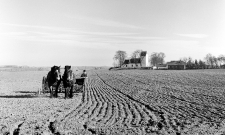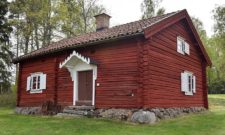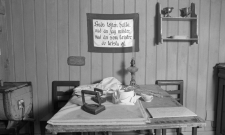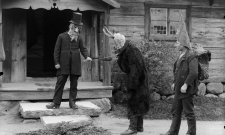Shop our historical maps

Jan
Claes Johan Ljungström (1819-1882) talks about his childhood home. Originally published in 1872 in Ny Illustrerad Tidning, also in 1916 in the Nordic Museum's yearbook Fataburen. Thanks to Daniel Estefors who sent in the text with a tender modernisation of the language.
The cottage in question was located in the southeastern forest of Västergötland. Birch groves surrounded it, the pine and spruce with trunks of alder cross-section grew at just a rifle range from it. It was not one of the oldest in the village, for it had a "panel roof", which, together with the four-lobed spruces on which it rested, was cut at least for both Christmas and Midsummer, perhaps also for Easter, Pentecost and Mickelsmäss, and above was an attic with even a kind of gable chamber, where clothes and more were stored.
Otherwise, the construction was the usual in the village: one entered the front room, which was on a level with the kitchen, and from which one could also enter the kitchen, which was also connected to the living room by a door. The latter had windows not less on both sides, than also on the gable. About a quarter of the area of the cottage was taken up by the "stovepipe" with its large triangular fireplace and the baking oven, existing on the right, when one entered. On the left long wall was a wall-mounted cupboard, reaching from floor to ceiling, called the "office," constituting the pantry and milk-chamber.
In front of it was a small bench for the water-table and so on; further one of the common wooden sofas of the people, with the name of "bench", a name retained in the village since ancient times, when the long wall had its bench of a rough log, such as still existed at the time in question in a couple of cottages in the neighbourhood; mainly a pull-bed with fitted sheets. Between this and the great table, which stood in the middle of the gable window, with a chair at each end, was the wall clock in its case. Next was a chest of drawers with a carved flap, and a cupboard with bottles, from which, on solemn occasions, or when workmen were in the house, the tempting liquor of starch was not altogether absent.
The south long side had a "bench", a cupboard with a table top on it, the "dining-table" and chairs, etc.; and in addition there were some "quadrupeds", that is, chairs made of slabs of board with four legs drilled under each, to the furniture, to which may also reasonably be counted the hewing-cube standing near the door, a standing log-end of a cubit in height and at least half a cubit in diameter. In the corner next to it, nearest to the fireplace, in which corner the wood was always placed, birch bark was never missing.
This was the home of man, woman and son.
The woman was, as almost always among the Swedish commoners, the first to wake up in the morning, get up and "bake", that is, light a fire in the stove.
If the fire was well "fixed" the night before, that some spark was present when stirred in the ashes, the sulphur stick was1 immediately, or it was seized between two coals, whereupon it was blown until fire could be lit in a holding stick of wood. If the stove was "dead", then the "brittle" or "fuzzy" barrel had to be brought out and the steel and flint had to be used. In place of the flint was often used "cat stone" (quartz), preferably as the flint was rare and had to be brought home by "Gothenburg dangers", provided that one had not found a "thunderbolt", which was considered the safest fire-giving. The scabbard contained charred linen lobes, which were easily ignited by the spark from the steel. The soot barrel contained rotted, dried and grated wood of birch, willow (salix) or other soft deciduous trees, which flour at the top of the barrel was charred and further charred and burnt at each ignition, the mass being pushed up as required with a movable bottom. Tinder (lint of wood fungus) was a rarity, for it had to be bought for money; - Rubbing fire was never procured more often than when sick cattle were to be smoked healthy again.
With this chore the eighth was begun at four o'clock and quite often earlier. If you slept past 4 o'clock, you had overslept. - One cannot but wonder that so little sleep was needed; but the rule was this: "five hours' sleep not forgotten, six if you must, but not longer."
Soon a crackling and glowing fire blazed, and the whirring spinning wheel was set in motion, usually to the whine of some morning psalm. Soon the man was up, too, if he was not already, as the woman had not succeeded in getting a fire, and he went on with his business of the evening before, either until daylight or he had to go to his day's work. The son was allowed to sleep a little longer, but not past 6 o'clock.
At that time, coffee was a diet known only by name in this house. Although the parents had been to other places and enjoyed this drink, the child had never tasted it even at the age of 13-14. Breakfast was eaten as soon as it had been prepared, and consisted mostly of potatoes, peeled by each person, and a piece of herring fried on the fire in the stove for each person, unless the whole breakfast preparation consisted in preparing a dish of milk and the necessary bread. Knives were used somewhat; but forks were an article of which little need was felt.
"As soon as one saw", the woman went to look after the inhabitants of the flock-house, and the man and son went either to the lodge to do the threshing and other related work, or to the forest to cut wood or timber, as long as no handicrafts were done indoors. This, however, was usually done on stormy days, unless circumstances dictated otherwise. - The snow cutting was also a not unimportant work, because still, 40 years ago, "the earth had not screamed further south", but one had even in Västergötland winters with cold, which shot pistol shots in the knots, and with snow, which was far more than alder depth, where it lay in the forest even and had multiple alder high drifts, where such at houses or gardens could find a campsite.
The day's work was thus going on outdoors, and indoors the distaff was whirring or the cards were scratching, the loom was slamming, even sometime in the wintertime, except that the midday meal was being cooked. This was taken at the "dinner table", except on rarer occasions, such as feast days, or when a dear friend or relative was visiting, or some craftsman was engaged to practise his trade for the good of the house. The "mat board" was a kind of alder-high table with four legs, made like the four-legged ones. This was laid out on the floor, kindly near the warming fireplace, and on it was never laid a cloth, but it was "washed up" after the meal.
The afternoon's work was the same as the morning's except for the always unaccustomed "making up" of "evening wood," that is, sufficient fuel for the evening and the eighth, and, as far as possible, a few "tar sticks," that is, small pieces of tar, necessary for raising the glow of the fire, for no other "light" was provided, unless the spinge-stick was used. Tallow candles were too expensive, and lamps were a virtually unknown commodity, so that without one they required the purchase of oil. Cheap kerosene was not yet available. Even the tailor and the "barbed-wire printer" sometimes had to put up with the illumination of the "spingstick", which, though brighter than that of a talgdank, was not generally well received by the artistic masters of the awl or pry.
After the evening wood had been burnt at dusk, the cattle fed, and water brought home from the spring, which should always be done before dark, for if otherwise, "it was not good," for even then an ember was thrown into the pot, when it came in, a fire was made, and a lively blaze spread its light. Wood was by no means saved, but the fire was thoroughly maintained, that one "might see".
Around the stove, people gathered, each with their own occupation. Even the cat, who was practically a member of the family, was given a chair, which he immediately occupied, and where he had a spinning match with his mother, whose rocking-wheel whirled rapidly about, while she occasionally hummed a hymn, of course from the old hymn-book of 1695, which she had learned in her youth. The new one of 1819 was little to her taste, and its compilers were by no means praised by her for "pampering the old hymns," which they had reworked and incorporated into their work. - The man stood at the hewing-knob and roughly cut all kinds of wood: wheel-bars, sledge-bars, shovel-material, and so on, or also "pinned sticks", which were taken, according to the nature of the wood, on the "bottle", that is, after the growth rings of the piece of pine-tree cut out at about 1 ½ inches square and 5-6 blocks long, or also "on the spikes", that is, the splitting went across the growth-rings. Hence this illuminating material got the name of "bottle-sticks", or "bait-sticks", which, when used, must, if they were to burn and illuminate well, be held the former with the broad side, the latter with the edge upwards, wherefore also the "light-cutter" had two "cogs". This, which was used when no one was at hand to hold the stick, consisted of a sturdy end, bored into a board, and provided at the top with split iron tongues, one standing up, one sitting on the side, and in these the sticks were squeezed and held. - The son of the house either took part in his father's work or made and dipped sulphur sticks in an iron spoon with melted sulphur or read in a book, which was mostly done aloud. The library was not very rich, but books were borrowed from time to time, and for the rest what was available was read, even if it was for the seventh time, whatever the contents of the "conga books", as the woman called them, became fairly well known. These were by Hyphoff2, who began the Swedish reigns with the closest descendants of old Noah, Gog and Magog, as well as by Våhlin and others. One or two songs such as Sinclair's, Hönsgumman's and others were sung from time to time, when the mother was in the mood for secular singing.
So the evening went on under the shelter of the pennies of peace, joy and contentment. If a neighbour occasionally came in and "sat and talked", the conversation was lively, but blame was banned, at least as far as "the King and the Riksdan" were concerned. On the other hand, many tales were told of pirates, forest rats, trolls, sorcery, ghosts, and so on, which were believed by woman and child as surely as the description of the Flood.
After having eaten "supper" between 8 and 9 o'clock at the dining table in front of the fire, the work continued. The food was either potatoes, which were dipped in lingonberry puree diluted with milk without any other sweetener, or seasoned with a piece of herring roasted in embers, or porridge and milk, the porridge for the most part, sometimes made only of oatmeal and so hard that "one could ride over the barrel of a sharp-headed horse without leaving a mark on the seam".
At ten o'clock the work was put away, everything was put in its place, the son read a hymn or the couple together and prayers from Sturm's prayer book, Eneroth's Burning Offering of Prayer, or some other devotional book. Then the fire was lit, the fire was "fixed", that is, the embers were buried in the fire-mortar and ashes, and the damper was fired, while the pinstick shone. Finally, the floor was swept, for such was the woman's teaching: "if you sweep at night, the angels of God dance at night on your golf". They went to bed by the stick, which was placed on the stove and allowed to burn until it itself went out, and during which they further entrusted themselves into God's hand.
Yet3 the same simple customs and practices prevail to some extent in the same place in one cottage or another; but a few and forty winters have, however, with their winds swept away most and - perhaps the best.
Sources
- Sulphur sticks were sticks dipped in molten sulphur.
- Brief introduction to the old and new Swedish History. Stockholm 1731.
- Year 1872
Subscribe to YouTube:
If you appreciate Allmogens independent work to portray our fine Swedish history and Nordic culture, you are welcome to buy something nice in the shop or support us with a voluntary donation. Thank you in advance!
Support Allmogens via Swish: 123 258 97 29
Support Allmogens by becoming a member
Support Allmogens in your will








